
Reading Time: 9 mins
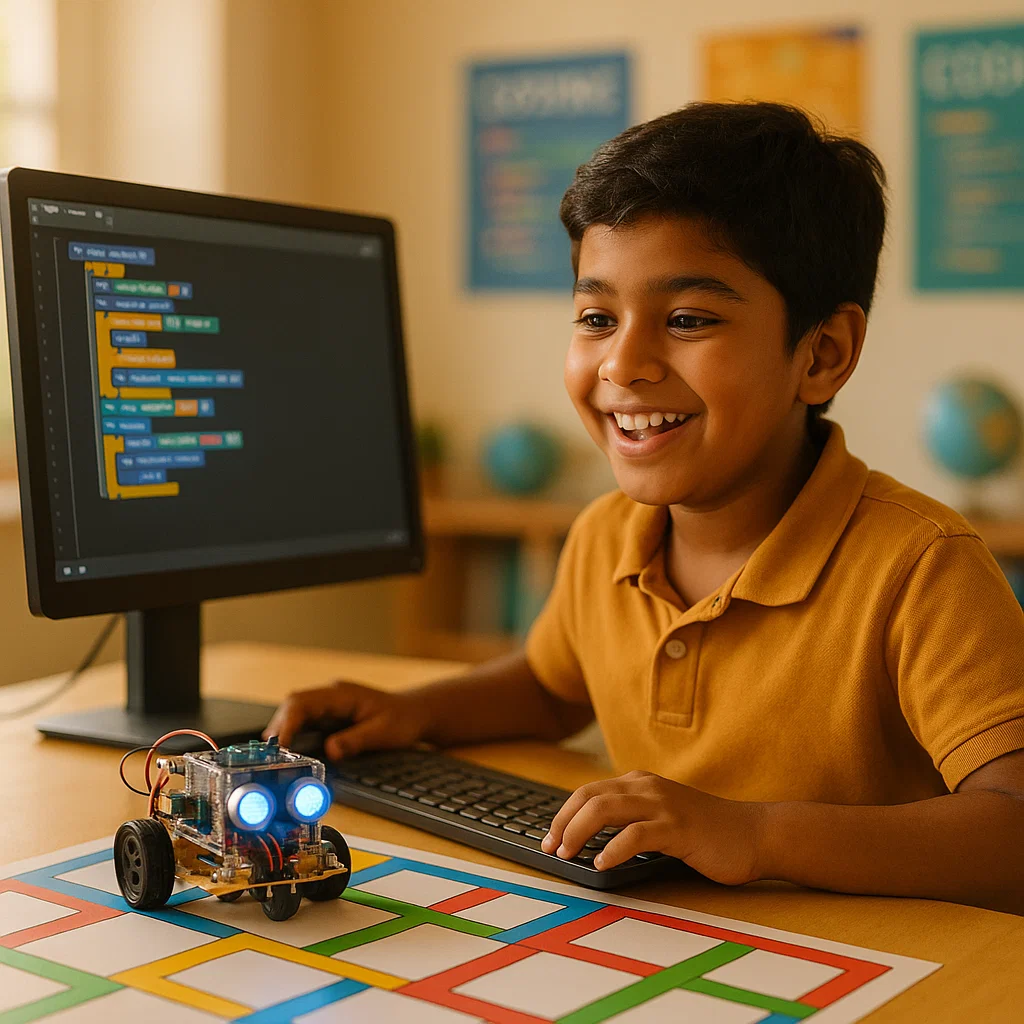
Picture this: Your 10-year-old sits at the computer, teaching a robot to navigate a maze using Scratch programming. They’re not just coding—they’re experiencing firsthand how artificial intelligence and human creativity work together. This collaboration between AI and human intelligence isn’t just shaping technology; it’s revolutionizing how our children learn, think, and prepare for tomorrow’s world.
As parents and educators in 2025, we’re witnessing an unprecedented transformation in education. The question isn’t whether AI will replace human intelligence—it’s how these two forms of intelligence can complement each other to unlock our children’s full potential. At ItsMyBot, where we teach AI, robotics, and coding to kids aged 5-16, we see this synergy in action every day.
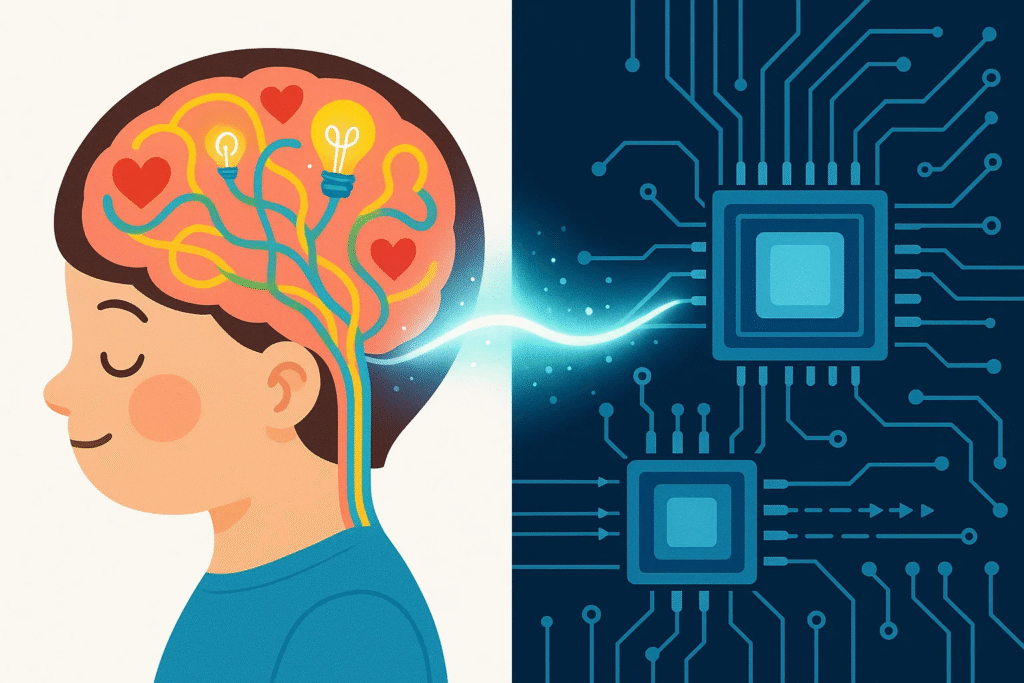
Human intelligence encompasses far more than processing information. When your child solves a puzzle, comforts a friend, or invents a new game, they’re demonstrating uniquely human capabilities that no AI can fully replicate. These include:
Emotional Intelligence and Empathy: Children naturally understand feelings—both their own and others’. When building a robot companion in our classes, students often program personalities that reflect their understanding of emotions, something AI struggles to genuinely comprehend.
Creative Problem-Solving: Watch a child with building blocks, and you’ll see innovation in action. They don’t just follow instructions; they imagine possibilities. This creative spark drives breakthroughs in STEM learning and beyond.
Adaptability and Learning from Experience: Unlike AI, which needs massive datasets, children learn from single experiences. One burned finger teaches fire safety better than a thousand warnings—this experiential learning shapes wisdom AI cannot achieve.
Moral and Ethical Reasoning: Even young children develop a sense of fairness and right versus wrong. This moral compass, refined through human experience and culture, guides decisions in ways algorithms cannot replicate.
Artificial intelligence excels in areas where human intelligence faces limitations. Understanding these strengths helps children work with AI tools more effectively:
Data Processing at Scale: While a human might take hours to analyze 100 math problems, AI can process millions in seconds. In our Python programming courses, students learn to leverage this computational power for complex calculations.
Pattern Recognition: AI identifies patterns humans might miss. Whether analyzing code bugs or optimizing game strategies, AI’s pattern-matching abilities complement human intuition beautifully.
Consistent Performance: Unlike humans who get tired or distracted, AI maintains consistent accuracy. This reliability makes AI perfect for repetitive tasks, freeing human intelligence for creative endeavors.
24/7 Availability: AI assistants never sleep, providing round-the-clock support for learning. Students in our online coding classes can practice anytime, with AI tools offering instant feedback.
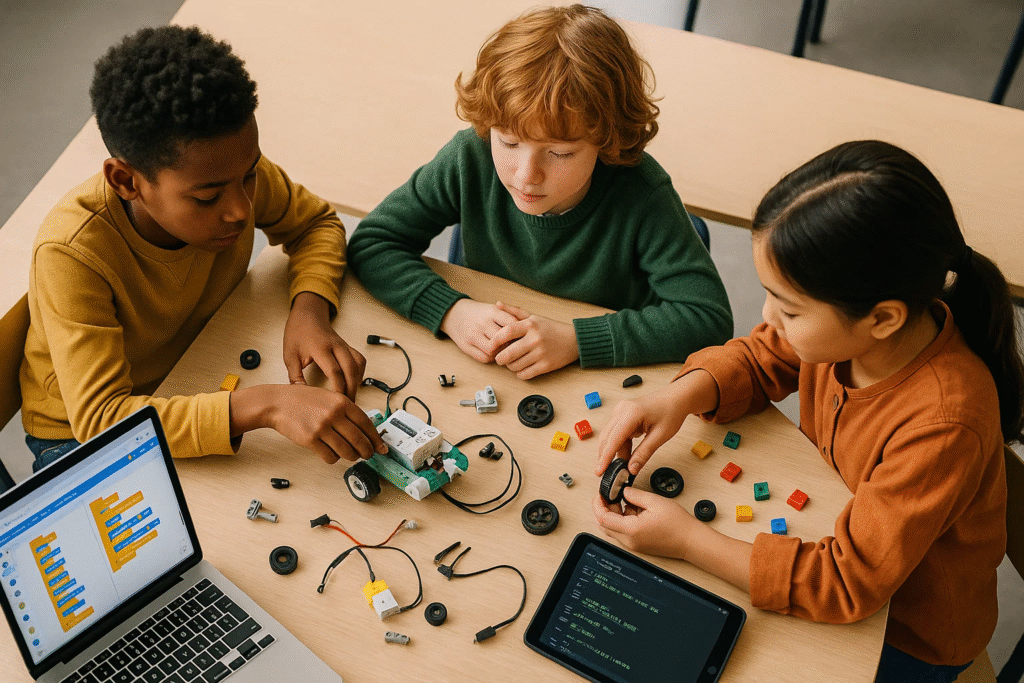
In educational settings, human intelligence brings irreplaceable value that shapes young minds:
Mentorship and Inspiration: A teacher’s encouragement can change a child’s life trajectory. When instructors at ItsMyBot celebrate a student’s first successful Python password generator, they’re building confidence AI cannot provide.
Understanding Context and Nuance: Human teachers recognize when a quiet student needs encouragement or when a joke might lighten frustration. This contextual awareness creates supportive learning environments where children thrive.
Adapting to Individual Learning Styles: Every child learns differently. Human educators intuitively adjust their approach—using visual aids for visual learners or hands-on projects for kinesthetic learners. Our block coding courses demonstrate this adaptive teaching daily.
AI brings unique advantages that amplify educational outcomes:
Personalized Learning Paths: AI algorithms analyze each student’s progress, identifying strengths and areas needing improvement. This data-driven personalization ensures no child falls behind or feels unchallenged.
Instant Feedback and Assessment: When students code a Snake game in Python, AI tools immediately highlight syntax errors and suggest improvements, accelerating the learning process.
Gamification and Engagement: AI-powered educational games make learning addictive—in the best way. Students master complex concepts while having fun, turning education into adventure.
Accessibility and Inclusion: AI tools help children with different abilities access education. Text-to-speech, visual recognition, and adaptive interfaces ensure every child can participate in robotics and coding activities.
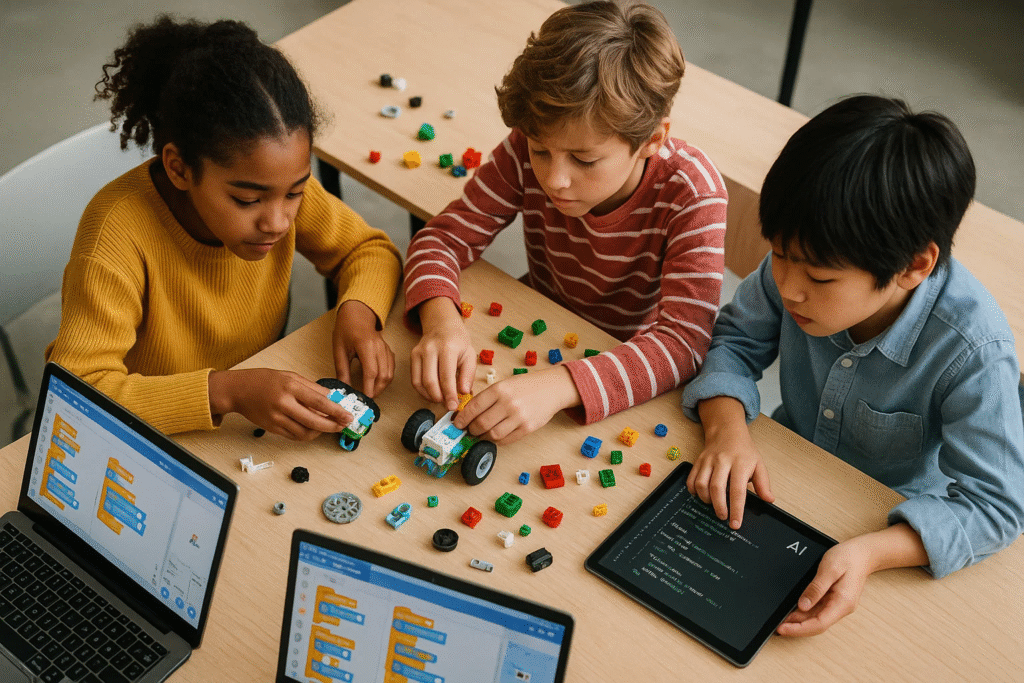
The magic happens when children combine their creativity with AI’s capabilities. In our robotics classes, students experience this synergy firsthand:
Collaborative Problem-Solving: Building a maze-solving robot requires both human creativity (designing the strategy) and AI algorithms (optimizing the path). Students learn that the best solutions emerge from this partnership.
Teaching Machines to Learn: Through machine learning projects, children train AI models to recognize objects or respond to voice commands. They discover they’re not being replaced by AI—they’re becoming AI trainers.
Debugging with AI Assistance: When code doesn’t work, AI tools help identify errors while human intelligence determines the best fix. This collaborative debugging teaches systematic problem-solving skills essential for future careers.
Creativity flourishes when AI handles technical complexity, freeing human imagination:
AI-Assisted Art and Music: Students use AI to generate base melodies or artwork, then apply human creativity to transform these into unique creations. Our music player projects in Scratch showcase this creative collaboration.
Story Generation and Game Design: AI helps generate story elements or game mechanics, but human intelligence crafts engaging narratives and meaningful gameplay. Students creating platformer games learn to blend AI suggestions with personal vision.
Code Optimization: While students write functional code, AI suggests optimizations. This partnership teaches efficiency while preserving individual coding style—crucial for developing programming expertise.
Teaching children about AI ethics isn’t just important—it’s essential for raising responsible digital citizens:
Data Privacy and Digital Footprints: Children must understand how AI uses their data. In our classes, we discuss why some information should stay private and how to make informed choices about sharing online.
Bias in AI Systems: Through simple experiments, students discover how AI can inherit human biases. They learn to question AI outputs and understand the importance of diverse perspectives in technology development.
Responsible AI Use: We teach students to use AI as a tool, not a crutch. They learn when it’s appropriate to use AI assistance and when human judgment should prevail—critical thinking for the AI age.
The future isn’t AI versus human intelligence—it’s AI with human intelligence:
Complementary Strengths: Like a robot with sensors (AI) and a creative programmer (human), the best outcomes emerge from combining different capabilities.
Augmented Intelligence: AI amplifies human abilities rather than replacing them. Students using NumPy for calculations still need mathematical understanding—AI just handles the computation faster.
Human-in-the-Loop Systems: The most effective AI systems keep humans involved in decision-making. Teaching this concept early prepares children for careers where they’ll supervise and guide AI systems.
The AI revolution demands new competencies alongside traditional skills:
Computational Thinking: Breaking complex problems into manageable parts—a skill developed through coding activities—becomes increasingly vital as AI handles routine tasks.
Critical Evaluation of AI Outputs: Children must learn to verify AI-generated information, understanding that AI can make mistakes or perpetuate misinformation. This skeptical thinking protects against blind trust in technology.
Emotional Intelligence Development: As AI handles more analytical tasks, human emotional intelligence becomes our unique value proposition. Activities that build empathy, communication, and leadership skills gain importance.
Continuous Learning Mindset: Technology evolves rapidly. Children who embrace lifelong learning—constantly acquiring new skills—will thrive in the AI era.
Many children (and parents) worry about AI replacing human jobs and capabilities. We address these concerns constructively:
Historical Perspective: Just as calculators didn’t eliminate mathematicians, AI won’t eliminate human intelligence. Instead, it creates new opportunities for those who understand both.
Empowerment Through Understanding: When children learn how to build chatbots, AI becomes less mysterious and more manageable. Knowledge replaces fear with confidence.
Focus on Uniquely Human Skills: Creativity, empathy, and ethical reasoning remain irreplaceable. By developing these alongside technical skills, children prepare for careers we can’t yet imagine.
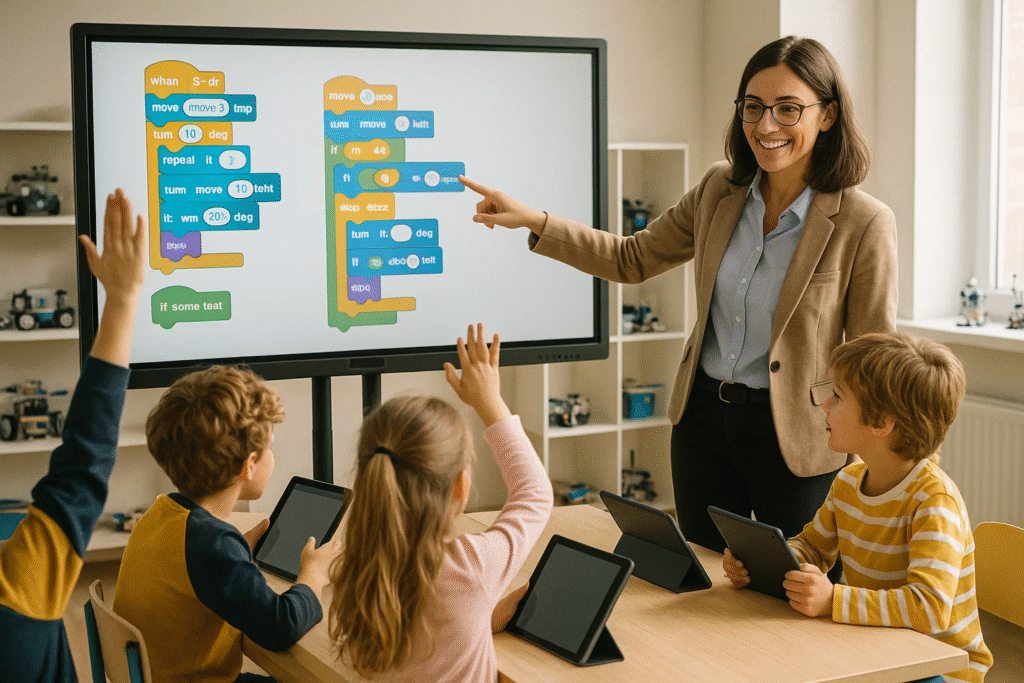
At ItsMyBot, we’ve developed a unique approach that harnesses both AI and human intelligence:
Live Interactive Sessions: Human instructors provide real-time guidance while AI tools offer personalized practice opportunities. This dual approach ensures every student receives both inspiration and individualized support.
Project-Based Learning: Students tackle real-world challenges that require both creative thinking and AI assistance. Building a Flappy Bird game teaches programming logic while AI helps optimize performance.
Peer Collaboration: Group projects combine multiple human perspectives with AI capabilities, teaching teamwork alongside technology. Students learn that the best solutions often emerge from diverse human insights enhanced by AI analysis.
Real examples demonstrate the power of combining AI and human intelligence:
Case Study 1: The Young Innovator: Eight-year-old Priya used AI image recognition in her drawing app project but added her unique artistic style to create something truly original. The AI handled technical complexity while her creativity made it special.
Case Study 2: The Problem Solver: Twelve-year-old Arjun struggled with traditional math until he discovered data visualization with Python. AI tools helped him process data, but his human insight revealed patterns that led to a school science fair victory.
Case Study 3: The Future Leader: Ten-year-old Maya learned to delegate tasks between herself and AI assistants in her robotics project. This early experience in human-AI collaboration prepared her for leadership in technology-driven environments.
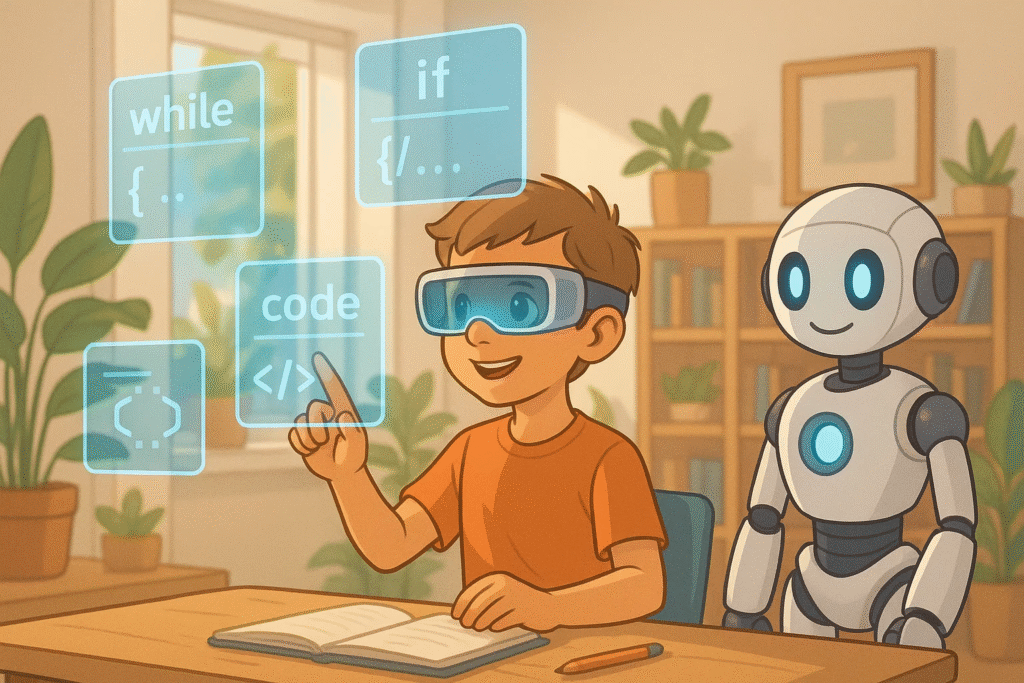
The educational landscape continues evolving with exciting developments:
Adaptive AI Tutors: Next-generation AI tutors will better understand emotional states, adjusting teaching methods based on student mood and engagement levels—though still requiring human oversight for genuine emotional support.
Augmented Reality Learning: AR applications will blend physical and digital worlds, with AI processing environmental data while human creativity designs engaging experiences. Imagine students exploring IoT concepts through AR visualizations.
Collaborative AI Projects: Students worldwide will collaborate on projects where AI handles translation and logistics while human creativity drives innovation—preparing them for global careers.
The jobs our children will hold may not exist today. This uncertainty makes the AI-human intelligence partnership even more critical:
Flexibility Over Specialization: While specific technical skills matter, the ability to adapt and learn new technologies matters more. Our comprehensive coding programs emphasize foundational thinking over memorization.
Ethics and Values: As AI becomes more powerful, human values become more important. Teaching children to apply ethical frameworks to technology decisions prepares them for leadership roles in AI governance.
Creative Confidence: In a world where AI handles routine tasks, human creativity becomes our superpower. Encouraging children to trust their creative instincts—even when AI suggests alternatives—builds irreplaceable confidence.
The debate of AI versus human intelligence misses the point entirely. The real opportunity lies in teaching our children to leverage both forms of intelligence symbiotically. At ItsMyBot, we witness daily how this partnership transforms young learners into confident, capable innovators.
Your child’s journey with AI and human intelligence starts with understanding that they’re not in competition with machines—they’re learning to conduct an orchestra where AI instruments amplify their human creativity. Whether they’re creating their first HTML webpage or programming advanced robotics systems, the combination of human imagination and AI capabilities opens doors we’re only beginning to imagine.
The future belongs to those who can bridge the gap between artificial and human intelligence, using technology as a tool while maintaining their uniquely human qualities. By starting this journey early through structured learning experiences, children develop not just technical skills but the wisdom to use them responsibly.
Ready to help your child master the AI-human intelligence partnership? Explore our live online courses where expert instructors and cutting-edge AI tools work together to unlock your child’s potential. Because in the end, the most powerful intelligence isn’t artificial or human—it’s both, working in harmony.
Want to learn more about preparing your child for an AI-enhanced future? Check out our comprehensive guides on machine learning for kids, robotics fundamentals, and the impact of AI on children’s education. Join the ItsMyBot community today and give your child the competitive edge they need for tomorrow’s world.
